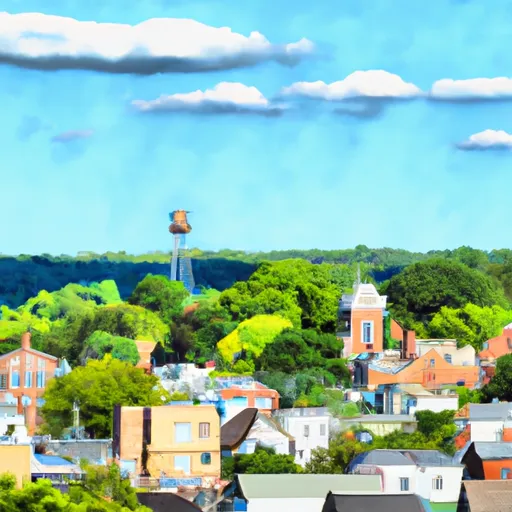-
 Snoflo Premium
Snoflo Premium
Get unlimited access to all our content
With no Ad interruptions! - Start Your Free Trial Login with existing account
Sherman
Eden Index
Climate
8.9
•
Recreation
5.6
•
Community
1.6
•
Safeguard
5.9/10

Sherman, Connecticut is a picturesque town located in Fairfield County, nestled in the scenic Litchfield Hills region of the state. The town experiences a humid continental climate, characterized by warm summers and cold winters. Average temperatures range from the mid-20s to mid-30s Fahrenheit in winter, while summer temperatures typically reach the mid-70s to low 80s Fahrenheit.
Sherman benefits from an abundance of natural beauty, with numerous rivers and lakes dotting its landscape. The town is home to Candlewood Lake, the largest man-made lake in Connecticut, providing ample opportunities for boating, fishing, and other water activities. The Housatonic River, which runs through Sherman, is another popular spot for kayaking and canoeing enthusiasts.
Outdoor recreation opportunities in Sherman extend beyond its waterways. The town boasts several parks and nature preserves, such as the Appalachian Trail and the Pootatuck State Forest, offering hiking trails and camping grounds. Additionally, the Blackberry River and Sherman Land Trust provide opportunities for wildlife observation, birdwatching, and picnicking.
Overall, Sherman, Connecticut offers a serene and nature-filled environment, allowing residents and visitors to enjoy a variety of outdoor activities all year round.
What is the Eden Index?
The Snoflo Eden Index serves as a comprehensive rating system for regions, evaluating their desirability through a holistic assessment of climate health, outdoor recreation opportunities, and natural disaster risk, acknowledging the profound impact of these factors on livability and well-being.
Climate Health Indicator (CHI): 8.9
Sherman receives approximately
1283mm of rain per year,
with humidity levels near 78%
and air temperatures averaging around
10°C.
Sherman has a plant hardyness factor of
6, meaning
plants and agriculture in this region thrive during a short period during spring and early summer. Most
plants will die off during the colder winter months.
By considering the ideal temperature range, reliable water supplies, clean air, and stable seasonal rain or snowpacks, the Climate Health Indicator (CHI) underscores the significance of a healthy climate as the foundation for quality living.
A healthy climate is paramount for ensuring a high quality of life and livability in a region, fostering both physical well-being and environmental harmony. This can be characterized by ideal temperatures, reliable access to water supplies, clean air, and consistent seasonal rain or snowpacks.
Weather Forecast
Streamflow Conditions
Connecticut Coastal
Area Rivers
Connecticut Coastal
Snowpack Depths
Connecticut Coastal
Reservoir Storage Capacity
Connecticut Coastal
Groundwater Levels
Recreational Opportunity Index (ROI): 5.6
The Recreational Opportunity Index (ROI) recognizes the value of outdoor recreational options, such as parks, hiking trails, camping sites, and fishing spots, while acknowledging that climate plays a pivotal role in ensuring the comfort and consistency of these experiences.
Access to outdoor recreational opportunities, encompassing activities such as parks, hiking, camping, and fishing, is crucial for overall well-being, and the climate plays a pivotal role in enabling and enhancing these experiences, ensuring that individuals can engage in nature-based activities comfortably and consistently.
Camping Areas
| Campground | Campsites | Reservations | Toilets | Showers | Elevation |
|---|---|---|---|---|---|
| Rudd Pond - Taconic State Park | None | 827 ft | |||
| Beartown State Forest | 12 | 1,614 ft | |||
| Macedonia Brook State Park | 50 | 808 ft | |||
| Ward Pound Ridge Reservation | None | 624 ft | |||
| Housatonic Meadows State Park | 100 | 456 ft | |||
| Mountain Lakes Park | None | 629 ft | |||
| Copake Falls - Taconic State Park | None | 678 ft | |||
| Lake Waramaug State Park | 75 | 719 ft | |||
| Lake Taghkanic State Park | None | 661 ft |
Nearby Fishing
Nearby Ski Areas
Catastrophe Safeguard Index (CSI):
The Catastrophe Safeguard Index (CSI) recognizes that natural disaster risk, encompassing floods, fires, hurricanes, and tornadoes, can drastically affect safety and the overall appeal of an area.
The level of natural disaster risk in a region significantly affects safety and the overall livability, with climate change amplifying these risks by potentially increasing the frequency and intensity of events like floods, fires, hurricanes, and tornadoes, thereby posing substantial challenges to community resilience and well-being.
Community Resilience Indicator (CRI): 1.6
The Community Resilience Indicator (CRI) recognizes that education, healthcare, and socioeconomics are crucial to the well-being of a region. The CRI acknowledges the profound impact of these elements on residents' overall quality of life. By evaluating educational resources, healthcare accessibility, and economic inclusivity, the index captures the essential aspects that contribute to a thriving community, fostering resident satisfaction, equity, and social cohesion.

